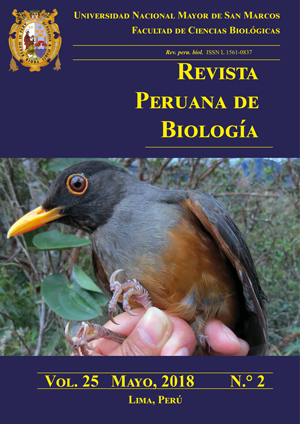Polyhydroxyalkanoates (PHA) performance of halophilic microorganisms isolated from salty lagoon
DOI:
https://doi.org/10.15381/rpb.v25i2.14249Keywords:
archaea, bacteria, biodegradable, bioplastics, petro-plastics.Abstract
In this work, we determine the polyhydroxyalkanoates (PHA) yield of microorganisms of soil and water from salty lagoons of Morrope, Lambayeque, Peru. Microorganisms were enriched in modified HM1 broth with 15, 20 and 25 g/100 mL of NaCl, incubated at 30 °C in aerobiosis. After observed turbidity or film, aliquots were taken and seeded on HM1 agar obtaining 234 bacterial isolates that by lipophilic Sudan Negro B staining were observed the presence of 93 bacterial isolates with PHA granules, which were cultured in HM2 broth with their respective concentrations of NaCl for 144 hours, quantifying a range of 4-85 cells with granules in five microscopic fields observed, selecting 20 bacterial isolates with the presence of 40-85 cells with granules, then they were taken to fermentation where the optimal incubation time was determined, where the cells are clearly differentiated with PHA granules. To determine the nature of the polymer produced, five bacterial isolates corresponding to the culture with the highest concentration of NaCl and the highest number of cells with PHA granules with the shortest growth time, but not necessarily the highest biomass, were selected, these reached 0.500; 0.300; 0.167; 0.183 and 0.417 gL-1 of PHA, with 1.850; 0.522; 0.275; 0.290 and 0.575 gL-1 of biomass and 0.270; 0.575; 0.607; 0.631 and 0.725 gg-1 yield Y (p/x). The highest yield was 72.52% of cellular mass in PHA being considered a promising and profitable performance for the extraction of the polymer.Downloads
Downloads
Published
Issue
Section
License
Copyright (c) 2018 Enrique III Idrogo Baigorria, Anasilvia del Pilar Flores Vásquez, Carmen Rosa Carreño Farfán

This work is licensed under a Creative Commons Attribution-NonCommercial-ShareAlike 4.0 International License.
AUTHORS RETAIN THEIR RIGHTS:
a. Authors retain their trade mark rights and patent, and also on any process or procedure described in the article.
b. Authors retain their right to share, copy, distribute, perform and publicly communicate their article (eg, to place their article in an institutional repository or publish it in a book), with an acknowledgment of its initial publication in the Revista Peruana de Biologia.
c. Authors retain theirs right to make a subsequent publication of their work, to use the article or any part thereof (eg a compilation of his papers, lecture notes, thesis, or a book), always indicating its initial publication in the Revista Peruana de Biologia (the originator of the work, journal, volume, number and date).






